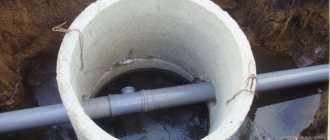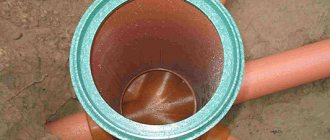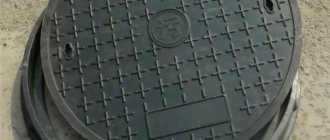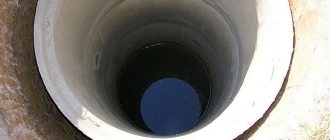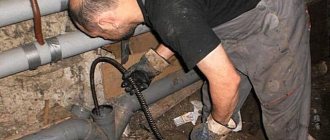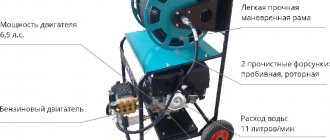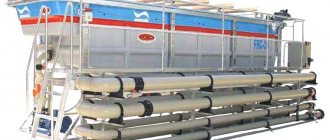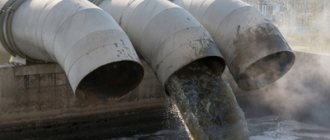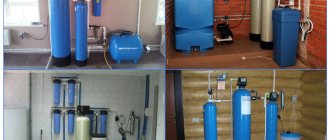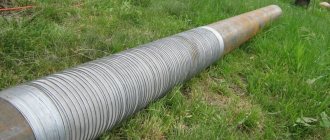Regular cleaning of sewer wells is a must. It is recommended to carry it out either as needed, in particular after the end of the winter period, or at intervals of six months. Modern technical capabilities make it possible to quickly and economically carry out not only preventive, but also emergency cleaning of wells. And in this article we will take a closer look at how to clean a sewer well.
Sewage pumping process
Types of sewer wells
There are several types of sewer wells. We will look at storage and filtering. All of them consist of a working container, a neck and a lid, and the distinctive feature of each is the structure of the bottom.
A storage sewer well is a large sealed tank into which all used liquid flows through the sewer pipes from the house. Its size depends on the number of people living and the volume of water they use. As soon as the liquid level in the well reaches a critical level, the operation of a sewer (sludge sucker) is necessary to clean the sewer well of silt and excess waste. The pumped out liquid is taken to a specially designated place.
The filter well is designed without a bottom; its role is played by a special multi-stage layer, for which broken brick, crushed stone, and gravel are used. The water, passing through the filter created in this way, is purified, and the well fills much more slowly. If the groundwater level rises, cleanup will definitely have to be called. If the groundwater level is high, preliminary wastewater treatment is necessary.
There is another type of well - a septic tank, a modern multi-stage treatment. To put it into operation, it is necessary to involve engineers and installers. You need to create a project and only then proceed with installation and commissioning.
In what cases is it advisable to use a drain cleaner?
If there is water in one inspection well and not in the other, it means that stagnation has formed between them, which the drain cleaner rods will help to cope with. Sewage cleaning starts from the well that has water in it and moves towards the clogged well.
For effective cleaning, you can and should use various attachments, which are usually included in the kit. The plunger attachment is designed to push the plug along the pipe, and if there is a need to push the plug in the opposite direction, scrapers will come to the rescue. After removing the plug, you can free the drain from contaminants using cleaning rollers and worm screws, which are also used at the initial stage of cleaning.
Situations that require drain cleaning
The earth does not have time to absorb all the incoming liquid, even with a drainage system in the septic tank. Sewage wells need to be cleaned periodically. And in order for this to happen quickly and easily, even at the construction stage, collector tanks are placed close to the road. It is important that a special vehicle can easily approach to pump out the septic tank.
Cleaning can be planned or emergency. Scheduled cleaning of the sewer well is necessary when the volume is filled to more than 75%. At the same time, if these activities are carried out regularly, no difficulties will arise in the operation of the septic tank. But if this is not done, the septic tank may overflow and flooding of the site and the surrounding area will occur. In this case, emergency pumping of the sewer well is inevitable.
This is labor-intensive and complex work, since after the well overflows, the sewer pipes become clogged with drain plugs. You will have to clean them too.
By neglecting routine inspection, you can expect that over time the pipe will become clogged with small debris, on which a layer of silt will build up. A blockage forms, making it more difficult for sewer water to pass through, and it fills the tank, overflowing it ahead of schedule. This is why it is so important to do routine septic tank cleaning.
Cleaning a well in a country house using an electric drainage pump
Self-pumping of silt or sand from a well using an electric drainage pump is most often carried out in the spring or during the rainy summer period, since high water, saturated with debris and other organic matter, penetrates into the well. The pump-out electric pump must be as powerful as possible and capable of operating without respite for 3-4 hours. Even a short stop in work is undesirable.
Cleaning a well shaft or well is divided into several stages:
- Drainage and vibration pumps are lowered into the well at the same time: a drainage pump is used to pump out silt and sand from the bottom; a vibration electric pump is designed to pump out contaminated water.
- According to the instructions, the drainage pump for pumping out sludge is suspended at a height of 500 mm from the bottom of the well shaft and fixed in this position for 2-4 hours.
- The evacuated vibration electric pump or pump, unlike the drainage pump, is pulled to the surface from time to time in order to clean it from contaminants in the filter elements.
In a two-hour continuous cleaning process, as a rule, no more than 100 mm of bottom sediment is removed.
When pumping sand from the well is completed, you need to start cleaning the walls without going down into it. To do this, you will need to purchase scrapers, which must be fixed to a pole or large-section wire. When the completely pumped out well is filled with water again, it can also be pumped out again using a vibration pump.
Factors on which the cost of cleaning a sewer well depends
You can actually deal with some sewer system clogs yourself. However, professional equipment and specialists are required to clean the entire system. Flushing sewer pipes, pumping a septic tank from a well, or using chemical reagents with your own hands will be difficult, troublesome and time-consuming, and possibly ineffective.
To solve this problem, it is better to use the services of a professional service. Of course, this is not a cheap pleasure, but it is necessary. Let's look at what the cost of cleaning a sewer well consists of.
First, the state of the system. Preventative regular washing will be cheaper than the first one done in a year or two. Therefore, it is necessary to carry out cleaning at least once a year. This will be enough to avoid overflow or deposits or traffic jams. This means that you will not need to resort to emergency cleaning services, and the price for scheduled cleaning of a sewer well is much lower than force majeure. Accordingly, a reasonable approach to maintaining the system will reduce your cost item in the future.
Secondly, on the method of cleaning sewer wells in a private house. We have already discussed above that, for example, the chemical method will be more expensive. The flushing method itself is chosen by a specialist based on an inspection of the sewer system and analysis of the data obtained.
How to clear a clog with a cable
Read more
Thirdly, the distance from the city center. If the house or cottage is located far away, then fuel consumption on the road increases, which means this will be included in the cost of cleaning. Plus the time spent on the road. Prices may vary, but if you take the average, cleaning a sewer well will cost around 5,000-7,000 rubles.
Most owners carry out cleaning by involving specialists. This is the key to efficiency, speed and professionalism.
Mechanization of work
When cleaning a well on a personal plot or dacha, manual labor is most often used, but when carrying out such activities on public facilities under the control of a responsible person, a drainage pump is widely used. With its help, water is not simply pumped out of the well, but active vortex of the liquid is ensured, which lifts sediment from the bottom and “rips off” buildup from the walls.
This mechanized cleaning is carried out as follows:
- lowering the pump or its inlet pipe into the well to a depth when approximately 40-60 cm remains to the bottom filter;
- the second (outlet) pipe of the pump directs the rising water flow back into the well water filling to create a vortex movement of the liquid;
- As the pump filter becomes contaminated with silty sediment, it rises and is cleaned.
In public wells, maintenance is often carried out by specialized teams. They have the ability to carry out cleaning using modern equipment:
- Special pumps - sludge suckers. They are a sewage disposal machine equipped with a medium-power vacuum pump and a container for sewage. Units are used to pump out water and a mixture of water and dirt from sewer systems, septic tanks, and wells.
- Hydrodynamic cleaning. It operates on the principle of sweeping away build-up and sediment using the energy of a water flow supplied under high pressure.
- Vacuum technology. Cleaning is ensured by a high-power vacuum pump, which allows you to pump out a mixture of any consistency into a special tank.
Cleaning storm drains using special equipment
The method described above is relevant for storm drains of small capacity, with the diameter of underground pipes no more than 200 mm.
Carrying out preventive or emergency work on large sewer facilities will require the intervention of professionals and the use of specialized equipment.
Tens of cubic meters of sand and silt deposits can accumulate in the cavities of pipes and wells in a compacted state, and it is simply unrealistic to remove them manually.
In almost all cities, enterprises for servicing underground communications have been created, which are armed with a fleet of machines specially designed for these purposes.
For high-quality cleaning of a storm drain overgrown with dirt, you will need a sewer washing machine and a vacuum suction unit.
Typically, this special equipment is installed on the wheelbase of powerful cars.
Some modern installations combine both functions - they are equipped with hydrants for flushing work and equipment for pumping washed sludge with a corresponding bunker.
- Such equipment is quite heavy and bulky, so even at the stormwater design stage, approaches to service points (wells and collectors) are provided.
The shorter the hoses used for supplying water and suctioning soil, the more effective the cleaning work.
Thus, before calling specialists, it is necessary to carefully prepare access roads, and, if necessary, make flooring on the ground to avoid slipping of heavy wheeled vehicles.
- The operation of the washing machine involves the use of a significant amount of water.
It is good if there is a stationary hydrant nearby, otherwise it is necessary to provide for the nearest water intake points.
- If pipes and large-diameter wells are severely clogged, cleaning will require periodic emptying of sludge bins.
It would be advisable to provide a site near the work site, from where the dried mud can then be loaded and removed using conventional dump trucks.
- To make a preliminary assessment of the condition of underground communications, specialists can use special telemetry devices - they provide a visual picture of the degree of clogging and integrity of the pipe walls.
Flushing technology
- The team arrives at the serviced site with a washing machine filled with clean water.
- A high-pressure hose with a special nozzle is inserted through the well into the body of the pipe from the descending part to a depth of 1-2 meters.
- After applying water pressure (180-200 bar), the washing process begins.
The nozzles on the head of the hose are located in a circle and are directed so that the water jets effectively wash the walls and create a reactive force that moves the hose forward in the pipe cavity.
Silty deposits are washed away by the flow of water and flow into the well.
- After passing the entire section, the hose is wound back without stopping the water supply, which ensures thorough cleaning.
- Washed sediments are cleaned out of the well manually, and if there is a significant amount of them, they are pumped out with a suction pump.
In the hopper of this machine, the pumped out masses are separated from water, which can be reused for the washing process.
As the bunkers are filled, the sludge pump is emptied at a waste disposal site or at a specially prepared site.
Pneumatic cleaning
In a number of cases, with old petrified deposits that are not amenable to conventional washing, pneumatic explosion technology is used.
Special pneumatic chucks introduced into the cleaning area create pulsed local water hammers, leading to short-term changes in the geometry of the pipe, which do not affect its integrity, but effectively chip off fossilized layers.
This technology is quite expensive, but in some cases it is the only possible one.
